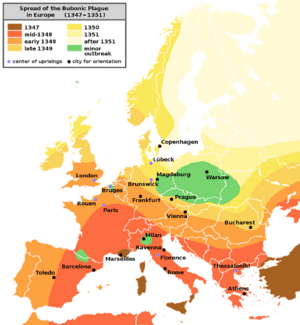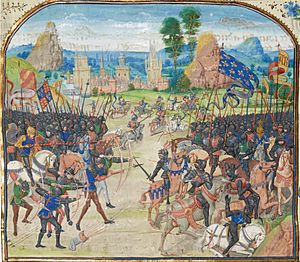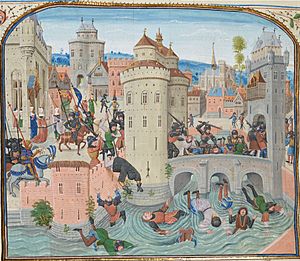Jean de Venette facts for kids
Quick facts for kids
Jean de Venette
|
|
|---|---|
| Born |
Jean de Venette
c. 1307 |
| Died | aft. 1370 |
| Nationality | French |
| Occupation | French Chronicler Carmelite friar |
Jean de Venette (born around 1307, died around 1370) was a French Carmelite friar. A friar is like a monk who lives in the community. He came from a town called Venette in France.
Jean de Venette became the leader (called a Prior) of the Carmelite monastery in Paris. He was also a main leader for the Carmelite order in France from 1341 to 1366. He is famous for writing a long French poem and a Latin chronicle. A chronicle is a record of historical events.
His chronicle tells us about the Hundred Years' War between England and France. Some historians think he also wrote a poem called L'Histoire des Trois Maries. Jean de Venette came from a peasant family. This means his writings give us a different view of history compared to other writers who were often from noble families.
Contents
The Chronicle: A Look at History
Jean de Venette's Chronicle is a story of important events between 1340 and 1368. He wrote down what was happening as it happened. This makes his chronicle a very good first-hand account of history.
The Chronicle starts in 1340. Jean de Venette writes about a priest who was held prisoner and then freed. This priest had a vision of a great famine (a time when there is not enough food) in 1315. Jean de Venette was only seven or eight years old then, but he remembered that the famine did happen.
He also explains how the Hundred Years' War began. He describes the fight for the French crown after King Philip the Fair died. He tells us about Edward I of England's claim to the French throne.
Major Events in the Chronicle
Jean de Venette's chronicle gives us many details about big events. He describes the Battle of Crécy in 1356. He also writes about the Peasant's War and the siege of Calais. A siege is when an army surrounds a city to try and take it over.
Historians find his work interesting because he was an intelligent person who saw many important and sad events. He offers a different view from other writers like Froissart, who often wrote about the nobles. Jean de Venette was not influenced by the official stories from the French kings.
Jean de Venette's Background
Jean de Venette studied theology at the University of Paris. Theology is the study of religious faith. He spent a lot of time helping younger Carmelites learn to read and write.
He believed that not knowing things caused many problems in his time. This included the terrible Black Death. He wanted Carmelites to be educated.
What makes Jean de Venette's work special is his understanding of peasants. Most writers at the time wrote from the point of view of rich nobles. Because he came from a humble background, he understood the hard lives of peasants. His writings cover major events like the Black Death, the Hundred Years' War, and the Peasant's War.
His Beliefs and the Stars
Jean de Venette strongly followed the teachings of the Pope. He believed in God's teachings and criticized anyone who did not follow them.
He also connected his religious beliefs with events in the sky, like comets. He thought these were "warnings" from God about punishment for people's sins. In 1340, he wrote about a comet that appeared. He also saw another comet in August 1348. This was around the time the Black Death started. He used parts of the Book of Revelation from the Bible to try and understand the chaos around him.
The Black Death

The Black Death was a terrible disease that arrived in Europe in 1348. Jean de Venette believed it came from "unbelievers." He wrote that more than 500 people were buried each day. The plague lasted about a year but came back in later years.
He noticed that some priests were too scared to visit the dying. But he praised the Sisters of the Hôtel-Dieu (a hospital). He said they "nursed the sick in all sweetness and humility," even though many of them died from the plague themselves.
The Hundred Years' War
Jean de Venette describes many battles of the Hundred Years' War. These include the Battle of Crécy, the siege of Calais, and the Battle of Poitiers.
For the Battle of Crécy, he remembers the exact date: "Saint Louis's Day, 1346." He mentions that the Genoese crossbows did not work because they were wet. He says the French King ordered the crossbowmen to be killed because he thought they were cowards. Jean de Venette blamed the French King's "undue haste" for the French army's confusion. He described the English longbow arrows as "rain coming from heaven."
Jean de Venette was known as a "child of the people." He often criticized the nobles for not protecting the common people. This was especially true after the Battle of Poitiers in 1356. In this battle, the King of France and his son were captured. They were held for a huge ransom.
The Peasant's War
Jean de Venette also wrote about the Peasant's War in France. This was part of the Hundred Years' War. He tells a story about a group of French peasants led by Guillaume l'Aloue. They defeated the English in several small fights.
After the French King was captured in 1356, power in France was very messy. Different groups like the States General and the King's son, the Dauphin (who later became Charles V), tried to take control. Jean de Venette also criticized the Companies (groups of soldiers for hire) who robbed peasants and churches.
L'Histoire des trois Maries

L'Histoire des trois Maries (meaning "Story of the three Marys") is a long French poem written around 1357. It was written by a Jean de Venette, but it might not be the same person as the chronicler. The poem is about three important Marys: Mary, the mother of Jesus, and two other Marys, Mary Cleophas and Mary Salome. They are described as the "three daughters of Saint Anne."
This poem has not been printed in a modern book. Copies of the poem can be found in old handwritten books (manuscripts) in libraries like the BnF in Paris and the British Library. One copy from the 1400s has 232 pages.
A simpler prose (story-like) version of the poem was finished in 1505 by Jean Drouyn. It was printed many times.




